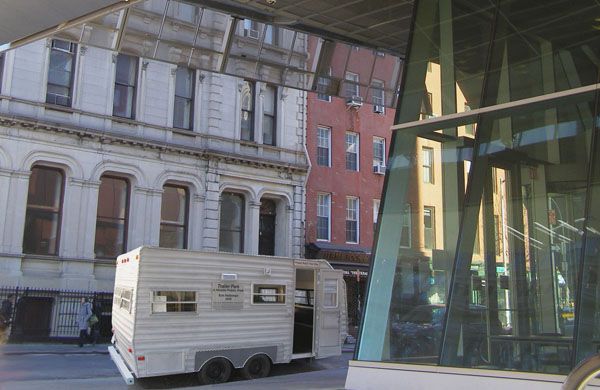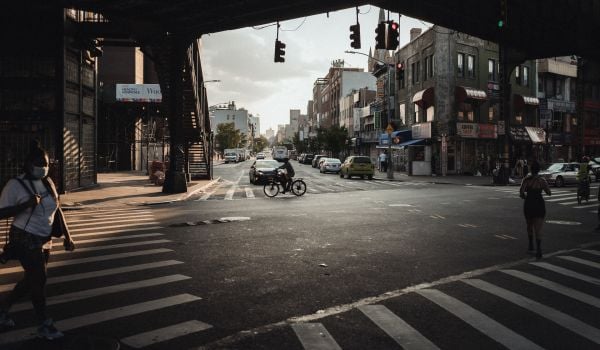This past January, I was walking past The Cooper Union School of Art on Third Avenue in Manhattan when I noticed something that looked peculiarly out of place, parked curbside right next to the school. It was a trailer. A smallish, generic trailer.
It turned out I was one of many New Yorkers to have stumbled across Trailer Park: A Mobile Public Park. It’s a trailer, with a park inside. And it’s parked.
When you walk in, you actually feel like you’re in a park. Short walls of red brick planter beds flourish with greenery; a stone waterfall gurgles with water; tiny benches allow city-worn pedestrians to have a rest; skylights fill the park with natural lighting. 
Trailer Park is the creation of 36-year-old artist Kim Holleman, an alumni of Cooper Union and The Rietveld Academie in Amsterdam. Holleman has devoted her career to experimenting with the political possibilities of artistic manipulation. In this case, she assembled a physical paradox.
“By combining the destination and the means to get there, with Trailer Park you walk inside to go outside,” Holleman says. “If you cannot go to the park, the park can go to you. A mobile metaphor and a transcendent experience, Trailer Park cautiously asks where we will go when there is no more nature—and playfully answers the question for us. It taps into our collective anxiety about the future of our environment, while allowing us a lush and utopian reprieve.”
Trailer Park has been spotted throughout the New York City boroughs since it first parked in 2006, but not until this summer did TrailerPark attract international attention. In June, Holleman learned that she and her trailer are semifinalists in the ONE PRIZE competition, a design competition that challenges artists, architects, engineers –or anyone else up to the challenge – to imagine ways to create and implement productive green spaces in cities. ONE PRIZE is hosted by Terraform ONE, a Brooklyn-based nonprofit that promotes green cities through ecological design.
If Holleman gets her way, Trailer Park will soon have an entire army of metal-shelled brothers and sisters. There are a lot of unused trailers in the United States, mostly because the Federal Emergency Management Agency (FEMA) houses displaced persons in trailers after natural disasters. Unused trailers are warehoused, sold, abandoned or sent to landfills. There are currently 102,000 abandoned FEMA trailers from Hurricane Katrina, which adds up to 357 million pounds of waste. These trailers are also contaminated with formaldehyde, a carcinogen. Because of this, Congress passed legislation that prevents these trailers from being used as homes. They are destined to the garbage dump.
Holleman proposes that these trailers be decontaminated and converted into mobile farms and gardens. She uses her own creation, Trailer Park, as prototype and proof that a trailer can be cheaply converted into an energy-efficient and mobile park or garden.
This July, Holleman has many opportunities to showcase Trailer Park and spread her gospel of the political and ecological potentialities of art and architecture. On July 14, Holleman will lecture at Terrefarm, a summer laboratory hosted by Terreform ONE that gathers students, architects, scientists and artists to explore urban agriculture solutions. And she’s taking her trailer with her: July 12 – 16, it will be parked right outside Terreform ONE, at 33 Flatbush Avenue in Brooklyn.
Mitchell Joachim, Ted Fellow and co-founder of Terreform ONE, believes Trailer Park cleverly manipulates America’s mobile culture for ecological benefit. “America has always been a nation on the road,” he says. “We desire to move the suburbs on small networked wheels—re-branding trailer culture—for a greener future.”
Interest in Holleman’s interdisciplinary approach is getting a lot of attention. Her two other upcoming shows, opening simultaneously with Terrefarm, also focus on the use of art and architecture as a means to address critical issues. Her work will be included July 10 – 17 at Smack Mellon’s Condensations of the Social exhibition, where she will build a protective, wave-like covering over the Flock House, a conjectural futuristic habitat that can survive rising tides. Opening July 17, she will also be at Superfront’s Artists That Play Well With Architects, where she will display detailed architectural models of utopian and dystopian future landscapes.
Trailer Park is Holleman’s artistic baby. Its very existence speaks to the dormant power of an artistic mindset applied to social issues. “I want people to see the concept, commitment, and physicality in this piece,” she says. “I have vehemently asserted that artists need to regain their position at the forefront of social and technological innovation, right alongside scientists and academics. I think of examples like Michelangelo and Da Vinci, who model an interdisciplinary practice, representing the artist as architect, artist as scientist, artist as inventor, artist as innovator.”
















